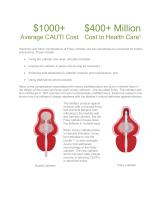
Catalog excerpts

How Foley Catheter Design Flaws May Lead to CAUTIs The Problem...and a Potential Solution Raul Ordorica, M.D. Kathleen M. Vollman, MSN, RN, CCNS, FCCM, FAAN August 2015 A non-catheterized bladder with a healthy mucosa exhibits no signs of trauma. A catheterized bladder exhibiting trauma caused by the Foley catheter tip.
Open the catalog to page 1
This document outlines a new national survey on clinicians’ attitudes about catheter-associated urinary tract infections (CAUTIs). It also provides an overview of CAUTI-related challenges, and it suggests solutions to this vexing and prevalent infection risk. Among key findings of the survey of infection preventionists and other clinicians: • Most clinicians say their hospital administration is putting “strong emphasis on CAUTI reduction.” A majority are concerned that their hospital’s nurses don’t adequately comply with CAUTI protocols. Nearly 80% think Foley catheters can cause trauma to...
Open the catalog to page 2
Average CAUTI Cost Cost to Health Care5 Infections and other complications of Foley catheter use can sometimes be prevented by certain precautions. These include: • Using the catheter only when clinically indicated Leaving the catheter in place only as long as necessary Enforcing safe standards for catheter insertion and maintenance, and Using alternatives where possible. Many of the complications associated with urinary catheterization are due to inherent flaws in the design of the most commonly used urinary catheter -- the so-called Foley. The catheter was first introduced in 1937 and has...
Open the catalog to page 3
How Complications of Foley Catheterization Occur While Foley catheters provide crucial clinical benefits for appropriate patients, they are also one of the leading causes of nosocomial infections in the intensive care unit (ICU).6 To understand how Foley catheterization itself leads to complications like CAUTI, one must appreciate the body’s own means of preventing urinary tract infections – and how Foley catheters break down those defenses. The bladder has two natural defense mechanisms: urination and the bladder’s mucosal lining. Here’s how the bladder’s own protections work: • Urination...
Open the catalog to page 4
The natural defensive structure of the bladder wall works very well – but it was “built” to fight bacteria, not withstand assaults from a mechanical device. Unfortunately, the bladder’s defense mechanisms were not fully understood when the Foley catheter was developed in 1937. Thus, a catheter was created that violates the transitional cell lining, directly causing infection and other complications. The Foley catheter breaches the wall’s defenses in several ways: • Pressure damage from catheter tip. As the bladder drains, it collapses around the tip of the Foley catheter. Most of the...
Open the catalog to page 5
Visual Evidence: How Foley Catheterization Harms the Bladder These photos, taken using a cystoscope, document both tip and aspiration damage to the bladder caused by Foley catheterization. All photos were taken just 24 to 72 hours after catheterization. Compare the six photos below to the photo of the healthy bladder to the left. “We all know that a healthier, less traumatized tissue will probably be more able to resist clinical infection when exposed to bacteria as compared to a more diseased and less healthy tissue.” -- Rabih Darouiche, MD, Baylor College of Medicine. 14 A...
Open the catalog to page 6
Promising Replacement for Foley Catheter A new device designed to replace the Foley catheter (Duette Urinary Drainage System, Poiesis Medical LLC in Jupiter, Fla.) substantially satisfies the criteria outlined in the previous section for an improved indwelling urinary catheter: The catheter has two balloons instead of the single balloon of the Foley device. The tip is enclosed in the second balloon, which serves as a cushion to prevent damage to the mucosal lining and bladder wall. In other words, there is no exposed tip to cause the tip pressure damage that is commonplace with Foley...
Open the catalog to page 7
Urinary Tract Infection (Catheter-Associated Urinary Tract Infection [CAUTI] and Non-Catheter-Associated Urinary Tract Infection [UTI]) and Other Urinary System Infection [USI]) Events. CDC Website. http://www.cdc.gov/ nhsn/PDFs/pscManual/7pscCAUTIcurrent.pdf Accessed May 18, 2015. 2 Efforts to improve patient safety result in 1.3 million fewer patient harms. Agency for Healthcare Research and Quality Website. Published December 2014. http://www.ahrq.gov/professionals/quality-patientsafety/pfp/interimhacrate2013.html Accessed July 22, 2015. 3 Healthcare-associated infection cost...
Open the catalog to page 8All Poiesis Medical catalogs and technical brochures
-
Costs of Catheterization
12 Pages



